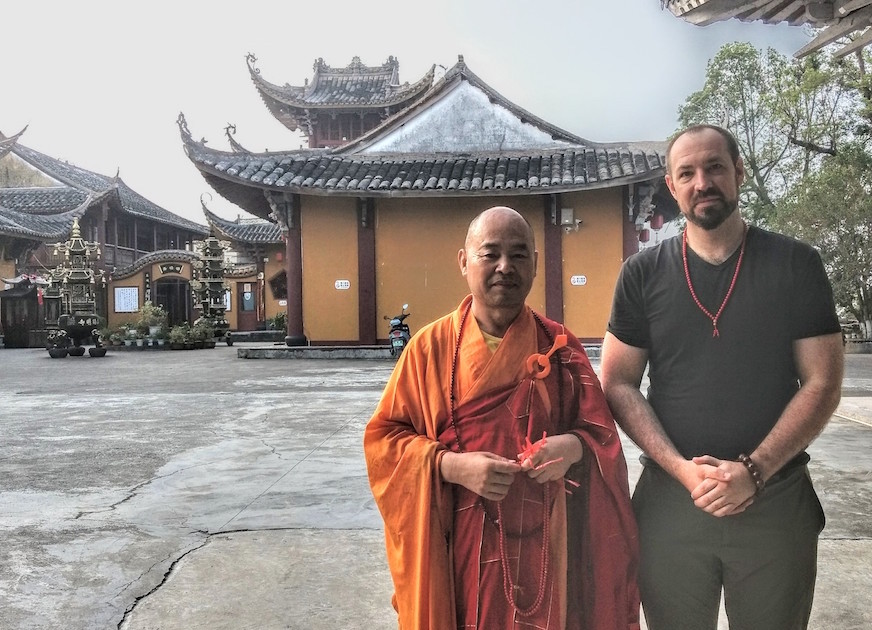In July I read the account of a philosopher spending time at the famous Trappist monastery called the Abbey of Gethsemani in Kentucky. This is the place where Thomas Merton lived for a while in the 1960s. Reflecting on the beauty and simplicity of monastic vocation, the philosopher wondered, “why do so few people choose this kind of life?”
The same can be asked of Buddhists in various traditions. Why do so few become monastics? Is the lay life particularly appealing? Or has monastic life become particularly unattractive?
It so happened that in July I was also living in a Buddhist monastery perched on a steep mountain-top outside of the city of Fuding, China. I hadn’t ordained, though I did take part in a head-shaving ceremony alongside many of our students and members of staff. Our time there was part of a Monastic Life Program called Woodenfish, which has a number of overlapping goals.
One is Buddhist education, and both monastics and lay academic teachers (myself as one of the latter) gave lectures on Buddhist history and practice. Another goal is cultural exchange, bringing around seventy students to China to learn about calligraphy, kung-fu, contemporary Chinese arts, and, of course, Chinese Buddhism.
Another purpose of the program is self-development for the participants. Monastic life is not easy. Many of us woke up at 3:10am, when the “clapper” (two pieces of wood slapped together to make a sharp clapping noise) was sounded for the monastics. Then a rooster would also sound an alarm around 3:15 for any still snoozing. At 5:10, our clapper would be sounded and students were expected to be ready for morning Tai Qi at 5:55. A full day followed, including three hours of academic lectures, Chinese cultural activities, meditation, and evening lectures.
Also taught, not by words but by modeling and experience, is a culture of harmony over individualistic desires. The structure of Chinese Buddhist life placed program participants at the bottom of a hierarchy, where their schedules were dictated to them, but their needs were also met by others. This meant that they couldn’t follow whatever desires or inclinations that happened to arise. But it also meant that they didn’t have to worry about what to do in the afternoon, where to eat, who to socialize with, and so on.
Program staff and instructors were up one rung in the hierarchy, with larger autonomy but still a great deal of structure. At the top were our program founder, Ven. Yifa, and the monastery’s abbot, who had considerable autonomy, but also the greatest responsibility and pressure to ensure the smooth running of activities for everyone who relied on them.
This structure is always foreign to some of our participants who are used to a more egalitarian and consumeristic approach, where “the customer is always right” and everyone is a customer. We did not seek input from participants except at the end of key activities. We instead relied on our cumulated years of experience -with those having the most experience also having the most influence- and treated new participants primarily as students to be led forth (this being the etymological root of “educated”).
This is a major draw, for some, of monastic life. And no doubt a major turn-off for others. The freedom from certain habituated modes of thought, and perhaps addictions to foods, intoxicants, and social media, mirror the ancient freedoms that the Buddha spoke about when he said:
“Household life is crowded and dusty; life gone forth is wide open. It is not easy, while living in a home, to lead the holy life utterly perfect and pure as a polished shell.” (MN 36, “The Greater Discourse to Saccaka,” trans. Ñāṇamoli & Bodhi, 2001, p. 335, para. 12.)
Monastic life, with its rigid schedules, rules, and hierarchy of power still is, perhaps ironically to some, a life wide open. Wide open to connecting with people on a level below small talk, below gossip or flirtations, below all householder concerns to a level of shared dignity and mutual respect. Monastic life is wide open to exploring one’s mind and experience in a regimented, deliberate method.
This isn’t to say that monastic life is easy, even for those clearly devoted to self-examination. Not only are fewer people choosing this vocation, but also many who do enter monastic life find little support from householders around them. Historical models of mutual gift-giving (the gift of dhamma for the gift of material support) are not as clear-cut in the modern world.
Times are changing, and our conceptions of monastic life will change with them. But this life, and the benefits that come with it, do not need to disappear.



[…] In Praise of the Monastic Experience, a Taste of Chinese BuddhismChina’s Harmony and Freedom from Fear […]